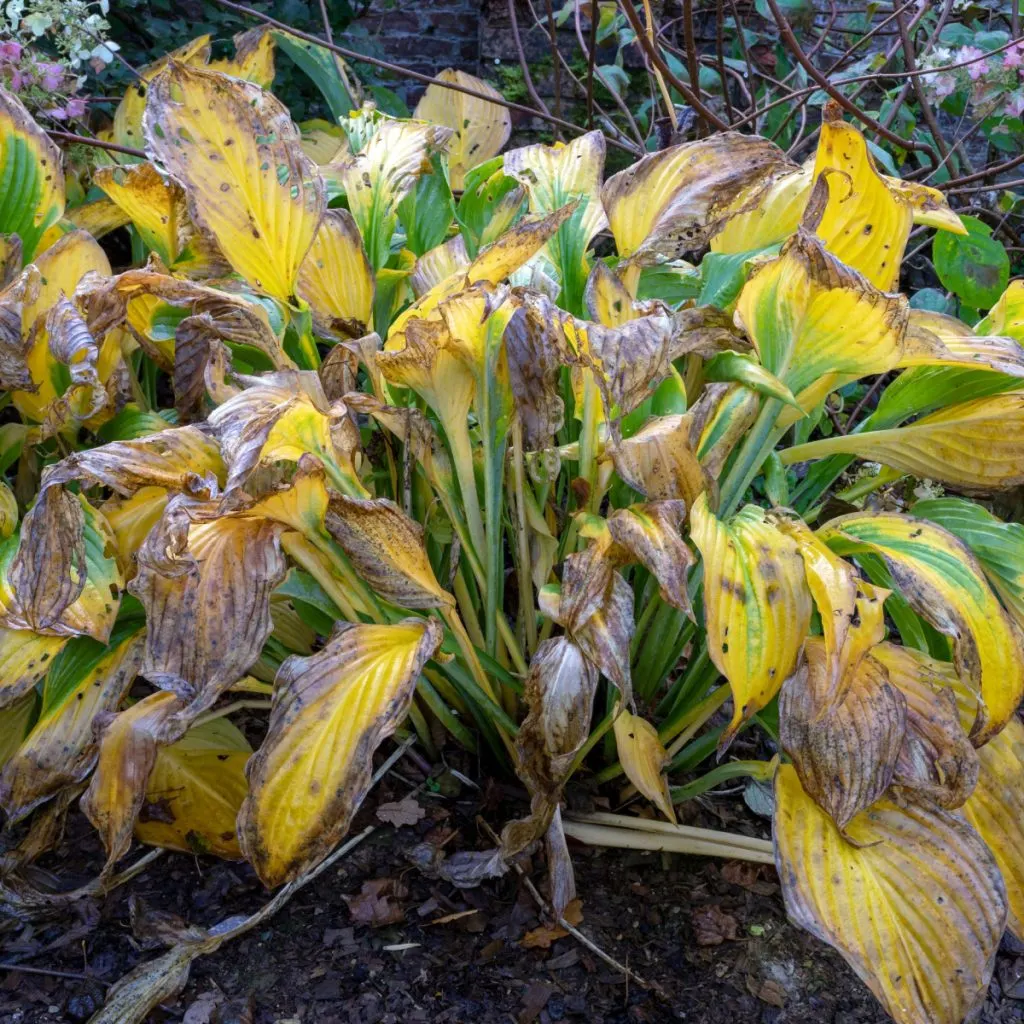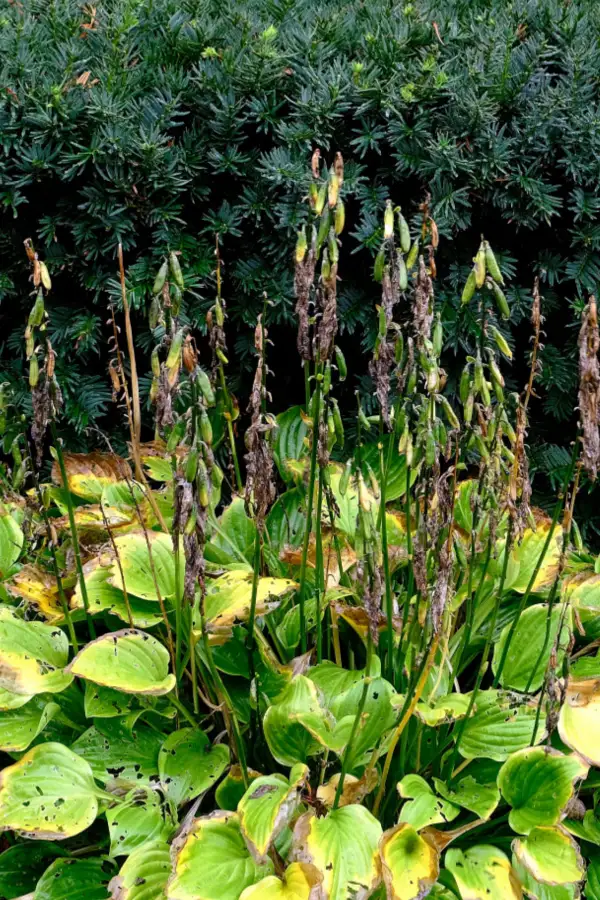Looking for a few hints, tips and tricks to help bring your hostas back to life this summer?
By the middle of summer, many hosta plants have all but lost their luster. The shade loving perennial that can be a showstopper early in the season can often fall victim to summer heat, insect attacks, and of course, hosta-loving deer, groundhogs and bunnies foraging on their tasty leaves.
What were once the stars of your spring and early summer flowerbeds can quickly become an eyesore. Especially right after they finish blooming and have decaying flower stems to add to the mix!
But here’s the good news – bringing your hostas back to life is actually easier than you can imagine. And yes, you can do it right in the middle of the summer. Not only can you have your plants looking great again in no time at all, you can also keep them that way right up until the first frost late in fall!
How To Bring Your Hostas Back To Life In The Summer!
Helping Hostas With Major Damage Come Back To Life
There are several ways to help struggling hosta plants in the middle of summer. The first order of business is determining just how much damage your hosta has sustained.
If your hosta has been heavily damaged by insects and/or animals chewing and munching on its leaves, the best course of action is to give your plants a complete refresh. And the way to do that is by completely pruning and cutting it back to ground level. Also see: How To Keep Your Hostas Safe From Slugs, Aphids & Other Insects!
Hostas are actually an incredibly resilient plant. In fact, so much so that they can be fairly hard to kill. Even when you remove all of their foliage right in the middle of the summer! But by cutting them back completely to the ground, you give them a chance to stop wasting their energy on trying to fix ailing leaves. Instead, they quickly refocus on sprouting fresh and blemish-free new foliage.
The good news is that the foliage will grow back fast. In fact, if you cut it down, give it a boost with a bit of fertilizer and water it well, it will often send up new shoots within a week!
Cutting Back Hostas In The Summer
For a fast restart, begin by cutting back your plants to ground level. We like to leave about 1/2 inch of the stock just to leave a little greenery and know where the plant is located for watering and fertilizing. It is always a good idea to sterilize your cutters between plants to avoid the danger of spreading any disease.
Next, it’s time to fertilize. Although granular fertilizers will work, they will provide a slower dose of nutrients. Instead, once cut back, fertilize the base of the plant with a good all purpose liquid fertilizer. Liquid fertilizer works fast. It feeds through the roots and remaining stems and will jump start growth.
For best results, choose an all purpose liquid fertilizer that has an equal amount or even slightly higher amount of nitrogen vs. phosphorous and potassium. Affiliate Link: Organic All-Purpose Liquid Plant Food – For Use On All Outdoor Plants.
The nitrogen helps with foliage growth, which is key for rejuvenating the leaves fast. Phosphorus and potassium help as well for overall plant health, but nitrogen is the key nutrient for leaf growth. And with more nitrogen, there will be more growth!
Caring For Plants After Cutting Back
Consistent watering is a big key to success for summer hostas to regrow and help bring them back to life. Plants should receive at least one inch of water per week from rain or hand watering. It is best to water deeply every few days to make sure the roots have enough moisture to promote growth instead of watering lightly every day.
In addition to consistent watering, applying an additional dose of fertilizer two weeks after cutting back will help fill out your plant quickly. Hostas do not require a lot of nutrients, but when cutting back in the summer, feeding them twice can have them looking great fast!
The good news is that many of the issues that can cause damage to hostas early in the year have disappeared by summer. The overly wet conditions of spring that can create large populations of slugs, aphids and snails that damage hostas usually disappear by summer, allowing your plants to stay fresh and vibrant right up until the first frost.

How To Rejuvenate Hostas With Minor Damage In The Summer
For those lucky enough to have only minor damage to their hostas, a full cut back is not necessary. Instead, for these plants, a few simple tasks can bring them right back to life. And for hostas, helping them to come alive again in the summer all starts with deadheading!
Deadheading Hosta Blooms
One of the best things you can do for hostas in the summer to help bring them back to life is to remove their fading bloom stems. And the sooner you do it, the better!
Much as with most flowering annuals and perennials, as long as the old flowers remain on the plant, they draw energy from the plant. Unfortunately, nearly all flowering plants try to fix or heal old blooms with more energy. They do this even though no amount of energy will ever bring the fading flower back to life.
The key when deadheading hostas is to remove not just the flower but the stem as well. If you only remove the spent flower head, the flow of resources will not end.
When deadheading hosta stems and spent blooms, cut the stem all the way back to the base. Simply follow the flower stalk down below the foliage and cut with a sharp pair of scissors or pruners. By doing this, you instantly stop the drain of resources the plant is using, trying to “heal” the old bloom and stem.
At the same time, remove any leaves that have serious damage. This too will help the plant stop using resources to heal and instead use them for growth.
Removing Blooms Before They Open
Most gardeners grow hosta plants for the beauty of their leaves, not their blooms. But unfortunately, the process of flowering takes a lot of resources. And as the plant uses those resources to form blooms and flower, it often comes at the expense of the leaves getting enough power to stay strong.
Because of this, many gardeners actually remove their hosta’s bloom stems before they flower. They do this in order to conserve energy for the plant and keep its leaves brighter and stronger all season long. Something to think about in the future if you simply want healthier and stronger foliage!
Finally, for plants that only need minor cut backs and deadheading, a single dose of liquid fertilizer will help the hostas recover from blooming and help to promote better leafing as well.
Here is to bringing your hostas back to life this summer. And – to keeping them looking great right up until late fall! For more late summer perennial care tips, see our article: What To Do With Your Daisies In Late Summer – After They Bloom! Happy Gardening – Jim & Mary.
Old World Garden
Jim and Mary Competti have been writing gardening, DIY and recipe articles and books for over 15 years from their 46 acre Ohio farm. The two are frequent speakers on all things gardening and love to travel in their spare time.
As always, feel free to email us at thefarm@owgarden.com with comments, questions, or to simply say hello! You can sign up for our free email list in the subscribe now box in the middle of this article. Follow us on Facebook here : OWG Facebook. This article may contain affiliate links.




